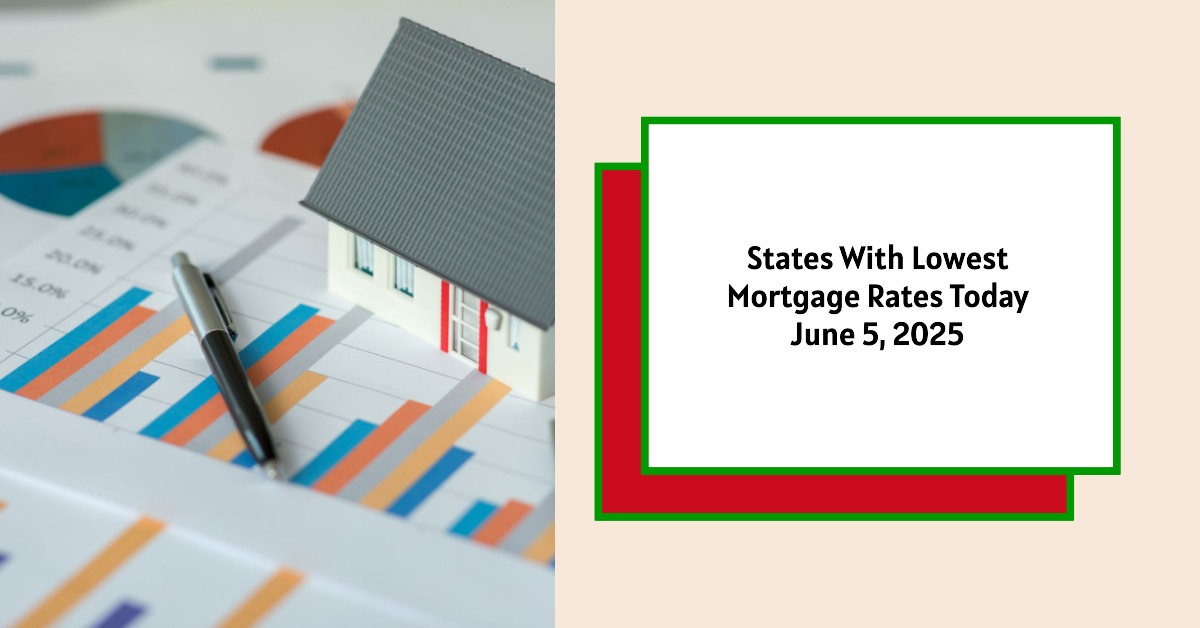Looking for the states where you can snag the cheapest mortgage rates right now? As of June 5, 2025, the states boasting the lowest 30-year mortgage rates are primarily New York, California, Massachusetts, Washington, Connecticut, Colorado, Pennsylvania, and Texas. These states are seeing averages between 6.74% and 6.89%.
Buying a home is a huge deal, and one of the biggest factors in your decision is going to be the mortgage rate you can get. Rates can change a lot from day to day, and they also vary depending on where you live. So, let's dive into which states are offering the most attractive rates today and what factors are at play.
States With Lowest Mortgage Rates Today – June 5, 2025
Cheapest vs. Most Expensive: A Snapshot of Today's Rates
According to Investopedia, here's a quick overview of where you'll find the best and worst 30-year mortgage rates on June 5, 2025:
- States with Lowest Rates (6.74% – 6.89%):
- New York
- California
- Massachusetts
- Washington
- Connecticut
- Colorado
- Pennsylvania
- Texas
- States with Highest Rates (6.98% – 7.09%):
- Alaska
- Kansas
- Mississippi
- Vermont
- Iowa
- Maine
- New Mexico
- North Dakota
- West Virginia
Why the Differences? Understanding the State-by-State Variations
You might be wondering, why this geographical disparity? What makes some states hotspots for low mortgage rates while others lag behind?
Several factors contribute to these state-level differences. It isn't as simple as one single reason:
- Lender Presence & Competition: Different lenders operate in different regions, and the level of competition between them can significantly impact rates. Areas with more lenders vying for your business tend to offer better rates.
- Credit Score Averages: States with higher average credit scores often see lower rates overall. This is because lenders view borrowers in these states as less risky.
- Average Loan Size: The average loan size in a state can also influence rates. Larger loans may come with slightly different rates than smaller ones.
- State Regulations: State-specific laws and regulations governing the mortgage industry can also play a role in determining interest rates. Some states may have policies that promote or hinder competition, affecting rate levels.
- Varying Risk Management Strategies: Each lender has its own way of assessing and managing risk. These internal strategies influence the rates they offer, leading to disparities even within the same state.
National Mortgage Rate Trends: Things are Changing
Although we're focusing on state-level data, it's important to look at the bigger picture. Here's how national rates are trending:
- Rates on 30-year mortgages have generally decreased over the last couple of weeks, reaching their lowest in over a month. This could indicate an easing of pressure on borrowers.
- Earlier this year, in March, 30-year rates dipped to their lowest average for 2025.
- And, thinking longer term, rates fell to a two-year low in September of the previous year.
To give you a bird’s-eye view, take a look at the averages of lenders’ best mortgage rates:
| Loan Type | New Purchase |
|---|---|
| 30-Year Fixed | 6.91% |
| FHA 30-Year Fixed | 7.37% |
| 15-Year Fixed | 5.90% |
| Jumbo 30-Year Fixed | 6.92% |
| 5/6 ARM | 7.23% |
Source: Zillow
Don't Believe the Hype: Understanding “Teaser” Rates
I want to give you a word of warning: be very cautious about advertised rates you see online! These “teaser” rates are often the absolute best-case scenario, not the reality for most borrowers. They are cherry-picked to be the most attractive versus the averages that you see here.
These rates are often tied to:
- Paying points upfront: This can lower your interest rate but means you're paying more out of pocket initially.
- Ultra-high credit scores: Only borrowers with exceptional credit will qualify.
- Smaller-than-typical loans: These may have different rate structures.
Remember, your actual mortgage rate will depend on your individual factors like:
- Credit score
- Income
- Debt-to-income ratio
- Down payment amount
Factor in All the Costs: Playing With the Numbers
Getting a low interest rate is great, but it's only one piece of the puzzle. You also need to consider all the other costs associated with buying a home. I always recommend playing with a mortgage calculator to get a sense of what your total monthly payment will be. This helps you to estimate potential monthly payments.
Here are some of the key costs to factor in, as the mortgage calculator shows:
- Principal & Interest: This pays off your actual loan.
- Property Taxes: These can vary drastically depending on your location.
- Homeowners Insurance: Protects your home against damage and liability.
Calculating your Monthly Payments:
| Factors | Amount |
|---|---|
| Home Price | $440,000 |
| Down Payment | $88,000 |
| Loan Term | 30 years |
| APR | 6.67% |
| Monthly Payment | $2,649.04 |
| Principal & Interest | $2,264.38 |
| Property Taxes | $256.67 |
| Homeowners Insurance | $128.00 |
| Mortgage Size | $352,000.00 |
| Mortgage Interest | $463,176.16 |
| Total Mortgage Paid | $815,176.16 |
Read More:
States With the Lowest Mortgage Rates on June 4, 2025
When Will Mortgage Rates Go Down from Current Highs in 2025?
Why Do Mortgage Rates Change? Peeling Back Layers
Understanding the why behind mortgage rate fluctuations can empower you to make better decisions about when to buy. Mortgage rates aren't pulled out of thin air; they're determined by a complex web of economic factors.
Here are some of the most important things that impact rates:
- The Bond Market: Keep an eye on 10-year Treasury yields. These are a major benchmark for mortgage rates.
- The Federal Reserve (The Fed): The Fed’s monetary policy and decisions on things like bond buying have a BIG impact.
- Competition Between Lenders: More competition = potentially lower rates for you.
- Inflation: Is inflation on the rise, or going down. This impacts all rate-sensitive products.
It's difficult to pin down any single factor as the sole cause of rate changes because they often move together. But those are the big ones to watch.
Expert Tips for Securing the Best Mortgage Rate
Based on my experience, here are some tips to keep in mind when shopping for a mortgage:
- Shop around! Get quotes from multiple lenders. Don't just settle for the first offer you see.
- Improve your credit score. Even a small improvement can make a big difference in your rate.
- Save for a larger down payment. This can lower your risk profile and lead to better rates.
- Consider a shorter loan term. 15-year mortgages usually have lower interest rates than 30-year ones (but higher monthly payments).
- Get pre-approved. This shows sellers you're a serious buyer and can give you leverage in negotiations.
- Don't be afraid to negotiate. Ask lenders if they can match or beat competitor's offers.
Mortgage rates are constantly changing, and they depend on a lot of stuff. Getting the best rate takes time and effort, but it's well worth it in the long run.
Invest in Real Estate in the Top U.S. Markets
Investing in turnkey real estate can help you secure consistent returns with fluctuating mortgage rates.
Expand your portfolio confidently, even in a shifting interest rate environment.
Speak with our expert investment counselors (No Obligation):
(800) 611-3060
Also Read:
- Will Mortgage Rates Go Down in 2025: Morgan Stanley's Forecast
- Expect High Mortgage Rates Until 2026: Fannie Mae's 2-Year Forecast
- Mortgage Rate Predictions 2025 from 4 Leading Housing Experts
- Mortgage Rates Forecast for the Next 3 Years: 2025 to 2027
- 30-Year Mortgage Rate Forecast for the Next 5 Years
- 15-Year Mortgage Rate Forecast for the Next 5 Years
- Why Are Mortgage Rates Going Up in 2025: Will Rates Drop?
- Why Are Mortgage Rates So High and Predictions for 2025
- Will Mortgage Rates Ever Be 3% Again in the Future?
- Mortgage Rates Predictions for Next 2 Years
- Mortgage Rate Predictions for Next 5 Years
- Mortgage Rate Predictions: Why 2% and 3% Rates are Out of Reach
- How Lower Mortgage Rates Can Save You Thousands?
- How to Get a Low Mortgage Interest Rate?
- Will Mortgage Rates Ever Be 4% Again?



